Composite Eco-Friendly Sound Absorbing Materials Made of Recycled Textile Waste and Biopolymers †
Abstract
:1. Introduction
2. Materials
2.1. Basic Components
2.2. Sample Preparation
2.3. Microstructural Analysis
3. Methods
3.1. Basic Physical Properties
3.2. Acoustic Properties
3.3. Ignitability Test
4. Results
4.1. Basic Physical Properties
4.2. Acoustic Properties
4.3. Effect of Air Gap
4.4. Ignitability Test
5. Practical Implications and Limitations
6. Conclusions
Author Contributions
Funding
Acknowledgments
Conflicts of Interest
References
- Joshi, S.V.; Drzal, L.T.; Mohanty, A.K.; Arora, S. Are natural fiber composites environmentally superior to glass fiber reinforced composites? Compos. Part A Appl. Sci. Manuf. 2004, 35, 371–376. [Google Scholar] [CrossRef]
- Hesterberg, T.W.; Hart, G.A. Synthetic Vitreous Fibers: A Review of Toxicology Research and Its Impact on Hazard Classification. Crit. Rev. Toxicol. 2001, 31, 1–53. [Google Scholar] [CrossRef]
- Bakatovich, A.; Davydenko, N.; Gaspar, F. Thermal insulating plates produced on the basis of vegetable agricultural waste. Energy Build. 2018, 180, 72–82. [Google Scholar] [CrossRef] [Green Version]
- Martellotta, F.; Cannavale, A.; De Matteis, V.; Ayr, U. Sustainable sound absorbers obtained from olive pruning wastes and chitosan binder. Appl. Acoust. 2018, 141, 71–78. [Google Scholar] [CrossRef]
- Kymalainen, H.R.; Sjoberg, A.M. Flax and hemp fibres as raw materials for thermal insulations. Build. Environ. 2008, 43, 1261–1269. [Google Scholar] [CrossRef]
- Zhou, X.Y.; Zheng, F.; Li, H.G.; Lv, C.L. An environment-friendly thermal insulation material from cotton stalk fibers. Energy Build. 2010, 42, 1070–1074. [Google Scholar] [CrossRef]
- Ashour, T.; Georg, H.; Wu, W. Performance of straw bale wall: A case of study. Energy Build. 2011, 43, 2518–2523. [Google Scholar] [CrossRef]
- Lim, Z.Y.; Putra, A.; Nor, M.J.M.; Yaakob, M.Y. Sound absorption performance of natural kenaf fibres. Appl. Acoust. 2018, 130, 107–114. [Google Scholar] [CrossRef]
- Fouladi, M.H.; Ayub, M.; Nor, M.J.M. Analysis of coir fiber acoustical characteristics. Appl. Acoust. 2011, 72, 35–42. [Google Scholar] [CrossRef]
- Wei, K.; Lv, C.; Chen, M.; Zhou, X.; Dai, Z.; Shen, D. Development and performance evaluation of a new thermal insulation material from rice straw using high frequency hot-pressing. Energy Build. 2015, 87, 116–122. [Google Scholar] [CrossRef]
- Berardi, U.; Iannace, G. Acoustic characterization of natural fibers for sound absorption applications. Build. Environ. 2015, 94, 840–852. [Google Scholar] [CrossRef]
- Rubino, C.; Liuzzi, S.; Stefanizzi, P.; Martellotta, F. Textile wastes in building sector: A review. Model. Meas. Control B 2018, 87, 172–179. [Google Scholar] [CrossRef]
- Ricciardi, P.; Belloni, E.; Cotana, F. Innovative panels with recycled materials: Thermal and acoustic performance and life cycle assessment. Appl. Energy. 2014, 134, 150–162. [Google Scholar] [CrossRef]
- Del Mar Barbero-Barrera, M.; Pombo, O.; de los Angeles Navacerrada, M. Textile fibre waste bindered with natural hydraulic lime. Compos. Part B 2016, 94, 26–33. [Google Scholar] [CrossRef]
- Echeverria, C.A.; Pahlevani, F.; Handoko, W.; Jiang, C.; Doolan, C.; Sahajwalla, V. Engineered hybrid fibre reinforced composites for sound absorption building applications. Resour. Conserv. Recy. 2019, 143, 1–14. [Google Scholar] [CrossRef]
- Leal Filho, W.; Ellams, D.; Han, S.; Tyler, D.; Boiten, V.J.; Paço, A.; Moora, H.; Balogun, A. A review of the socio economic advantages of textile recycling. J. Clean. Prod. 2019, 218, 10–20. [Google Scholar] [CrossRef]
- Sandin, G.; Roos, S.; Johansson, M. Environmental Impact of Textile Fibers-What We Know and What We Don’t Know; MISTRA Future Fashion report 2019:03 part 2; Rise AB: Göteborg, Sweden, 2019. [Google Scholar]
- Schmidt, A.; Watson, D.; Roos, S.; Askham, C.; Brunn Poulsen, P. Gaining benefits from discarded textiles; Rosendahls-Schultz Grafisk: Hillerød, Denmark, 2016; pp. 107–110. [Google Scholar]
- Munoz, I.; Rodriguez, C.; Gillet, D.; Moerschbacher, B.M. Life cycle assessment of chitosan production in India and Europe. Int. J. Life Cycle. Assess. 2018, 23, 1151–1160. [Google Scholar] [CrossRef] [Green Version]
- Mati-Baouche, N.; De Baynast, H.; Lebert, A.; Sun, S.; Lopez-Mingo, C.J.S.; Leclaire, P.; Michaud, P. Mechanical, thermal and acoustical characterizations of an insulating bio-based composite made from sunflower stalks particles and chitosan. Ind. Crops. Prod. 2014, 58, 244–250. [Google Scholar] [CrossRef] [Green Version]
- El Hage, R.; Khalaf, Y.; Lacoste, C.; Nakhl, M.; Lacroix, P.; Bergeret, A. A flame retarded chitosan binder for insulating miscanthus/recycled textile fibers reinforced biocomposites. J. Appl. Polym. Sci. 2019, 136, 47306. [Google Scholar] [CrossRef]
- Mati-Baouche, N.; de Baynast, H.; Michaud, P.; Dupont, T.; Leclaire, P. Sound absorption properties of a sunflower composite made from crushed stem particles and from chitosan bio-binder. Appl. Acoust. 2016, 111, 179–187. [Google Scholar] [CrossRef] [Green Version]
- Abuarra, A.; Hashim, R.; Bauk, S.; Kandaiya, S.; Taghizadeh Tousi, E. Fabrication and characterization of gum Arabic bonded Rhizophora spp. Particleboards. Mater. Des. 2014, 60, 108–115. [Google Scholar] [CrossRef]
- Elinwa, A.U.; Abdulbasir, G.; Abdulkadir, G. Gum Arabic as an admixture for cement concrete production. Constr. Build. Mater. 2018, 176, 201–212. [Google Scholar] [CrossRef]
- Baker, I. Wool. In Fifty Materials That Make the World; Springer: New York, NY, USA, 2018; pp. 261–265. [Google Scholar]
- Delany, M.E.; Bazley, E.N. Acoustical properties of fibrous materials. Appl. Acoust. 1970, 3, 105–116. [Google Scholar] [CrossRef]
- Johnson, D.L.; Koplik, J.; Dashen, R. Theory of dynamic permeability and tortuosity in fluid-saturated porous media. J. Fluid Mech. 1987, 176, 379–402. [Google Scholar] [CrossRef]
- Allard, J.F.; Champoux, Y. New empirical equation for sound propagation in rigid frame fibrous material. J. Acoust. Soc. Am. 1992, 91, 3346–3353. [Google Scholar] [CrossRef]
- ISO/IEC Guide 98-3:2008 (JCGM/WG1/100) Uncertainty of Measurement—Part 3: Guide to the Expression of Uncertainty in Measurement (GUM:1995); ISO: Geneva, Switzerland, 2008.
- Tridico, S.R. Natural animal textile fibres: Structure, characteristics and identification. In Identification of Textile Fibers; Houck, M.M., Ed.; Woodhead Publishing in Textiles: New York, NY, USA, 2009; pp. 27–67. [Google Scholar]
- Patnaik, A.; Mvubu, M.; Muniyasamy, S.; Botha, A. Thermal and sound insulation materials from waste wool and recycled polyester fibers and their biodegradation studies. Energy Build. 2015, 92, 161–169. [Google Scholar] [CrossRef]
- Brown, J.S. Connection between formation factor for electrical resistivity and fluid-solid coupling factors in Biot’s equations for acoustic waves in fluid-filled porous media. Geophysics 1980, 45, 1269–1275. [Google Scholar] [CrossRef]
- Pfretzschner, J.; Rodriguez, R.M. Acoustic properties of rubber crumbs. Polym. Test. 1999, 18, 81–92. [Google Scholar] [CrossRef]
- Berryman, J.G. Confirmation of Biot’s theory. Appl. Phys. Lett. 1980, 37, 382–384. [Google Scholar] [CrossRef]
- Ingard, U.K.; Dear, T.A. Measurement of acoustic flow resistance. J. Sound Vib. 1985, 103, 567–572. [Google Scholar] [CrossRef]
- Del Rey, R.; Alba, J.; Arenas, J.P.; Ramis, J. Evaluation of Two Alternative Procedures for Measuring Air Flow Resistance of Sound Absorbing Materials. Arch. Acoust. 2013, 38, 547–554. [Google Scholar]
- Jerman, M.; Černý, R. Effect of moisture content on heat and moisture transport and storage properties of thermal insulation materials. Energy Build. 2012, 53, 39–46. [Google Scholar] [CrossRef]
- Jerman, M.; Palomar, I.; Kočí, V.; Černý, R. Thermal and hygric properties of biomaterials suitable for interior thermal insulation systems in historical and traditional buildings. Build. Environ. 2019, 154, 81–88. [Google Scholar] [CrossRef]
- Gustafsson, S.E. Transient plane source techniques for thermal conductivity and thermal diffusivity measurements of solid materials. Rev. Sci. Instrum. 1991, 62, 797. [Google Scholar] [CrossRef]
- ISO 10534-2, Acoustics—Determination of Sound Absorption Coefficient and Impedance in Impedance Tubes—Part 2: Transfer-Function Method; ISO: Geneva, Switzerland, 1998.
- Cox, T.J.; D’Antonio, P.K. Acoustic Absorbers and Diffusers, Theory, Design and Application; Spon Press: London, UK, 2004; pp. 141–145. [Google Scholar]
- ISO 11925-2:2010, Reaction to Fire Tests—Ignitability of Products Subjected to Direct Impingement of Flame—Part 2: Single-Flame Source Test; ISO: Geneva, Switzerland, 2010.
- Mechel, F.P. Porous Absorbers. In Formulas of Acoustics; Mechel, F.P., Ed.; Springer: New York, NY, USA, 2008; pp. 348–402. [Google Scholar]
- Willie, M.R.J.; Spangles, M.B. Application of electrical resistivity measurements to problem of fluid flow in porous media. Am. Assoc. Pet. Geol. Bull. 1952, 36, 359–403. [Google Scholar]
- Del Rey, R.; Bertó, L.; Alba, J.; Arenas, J.P. Acoustic characterization of recycled textile materials used as core elements in noise barriers. Noise Control Eng. J. 2015, 63, 439–447. [Google Scholar] [CrossRef]
- Glé, P.; Blinet, T.; Guigou-Carter, C. Acoustic performance prediction for building elements including biobased fibrous materials. In Proceedings of the Euronoise 2018, Crete, Greece, 27–31 May 2018; pp. 27–31. [Google Scholar]
- Piégay, C.; Glé, P.; Gourdon, E.; Gourlay, E.; Marceau, S. Acoustical model of vegetal wools including two types of fibers. Appl. Acoust. 2018, 129, 36–46. [Google Scholar] [CrossRef]
- Carosio, F.; Alongi, J. Flame Retardant Multilayered Coatings on Acrylic Fabrics Prepared by One-Step Deposition of Chitosan/Montmorillonite Complexes. Fibers 2018, 6, 36. [Google Scholar] [CrossRef] [Green Version]
- No, H.K.; Meyers, S.P.; Prinyawiwatkul, W.; Xu, Z. Applications of chitosan for improvement of quality and shelf life of foods: A review. J. Food Sci. 2007, 72, 87–100. [Google Scholar] [CrossRef]
- Shehu, Z.; Lamayi, D.W.; Sabo, M.A.; Shafiu, M.M. Synthesis, Characterization and Antibacterial Activity of Kaolin/Gum Arabic Nanocomposite on Escherichia Coli and Pseudomonas Aeruginosa. Res. J. Nanosci. Eng. 2018, 2, 23–29. [Google Scholar]
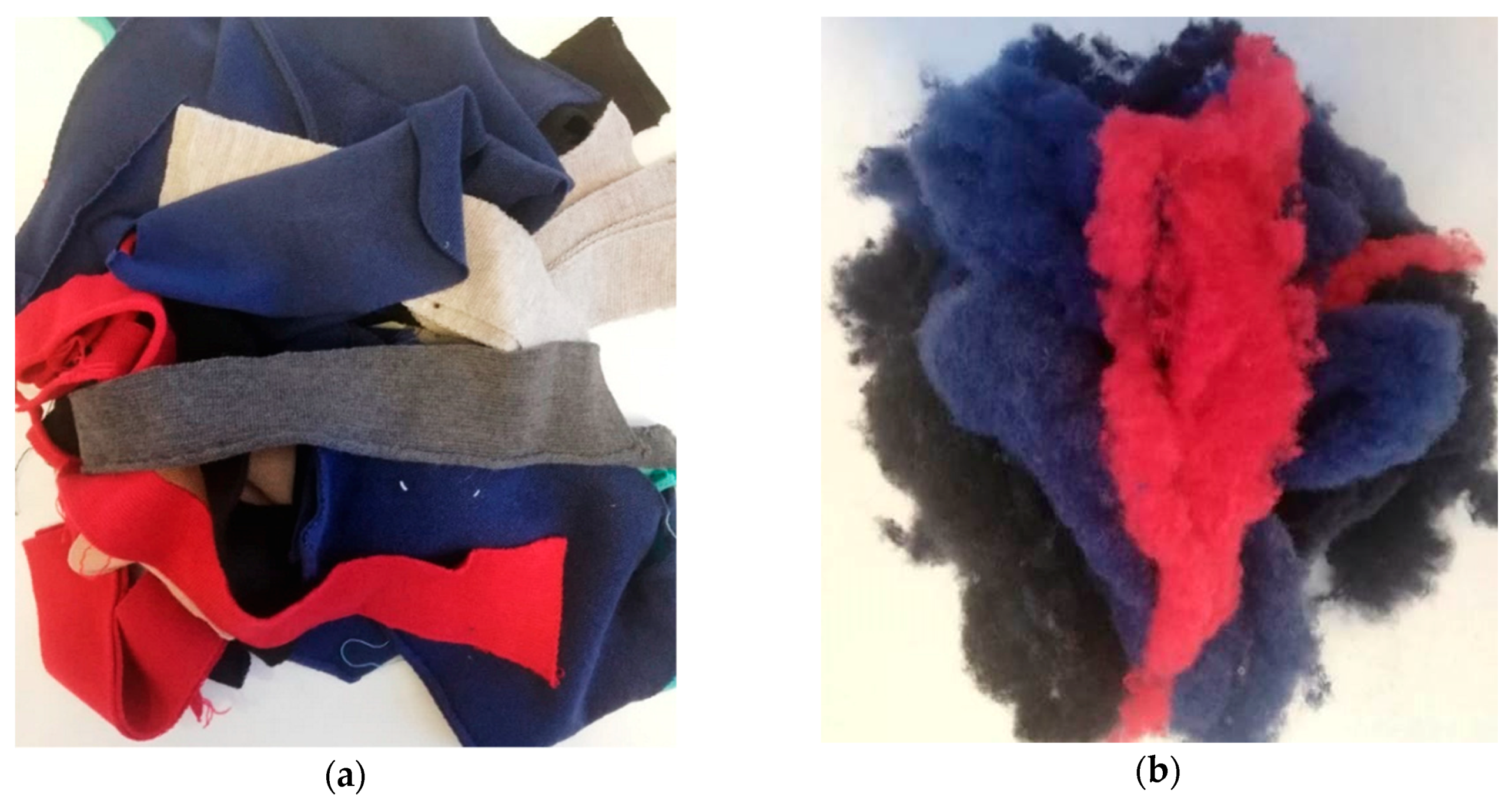
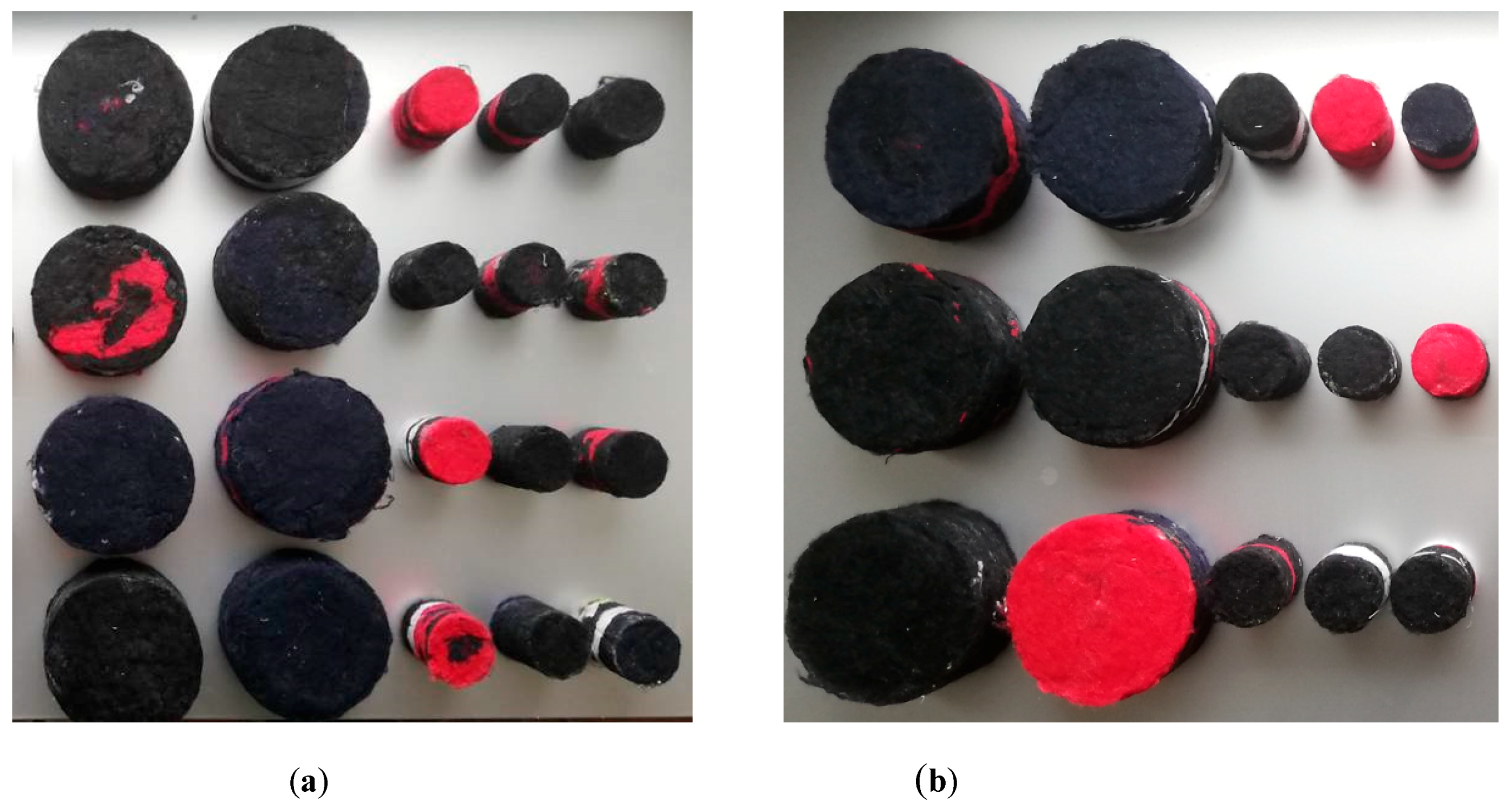
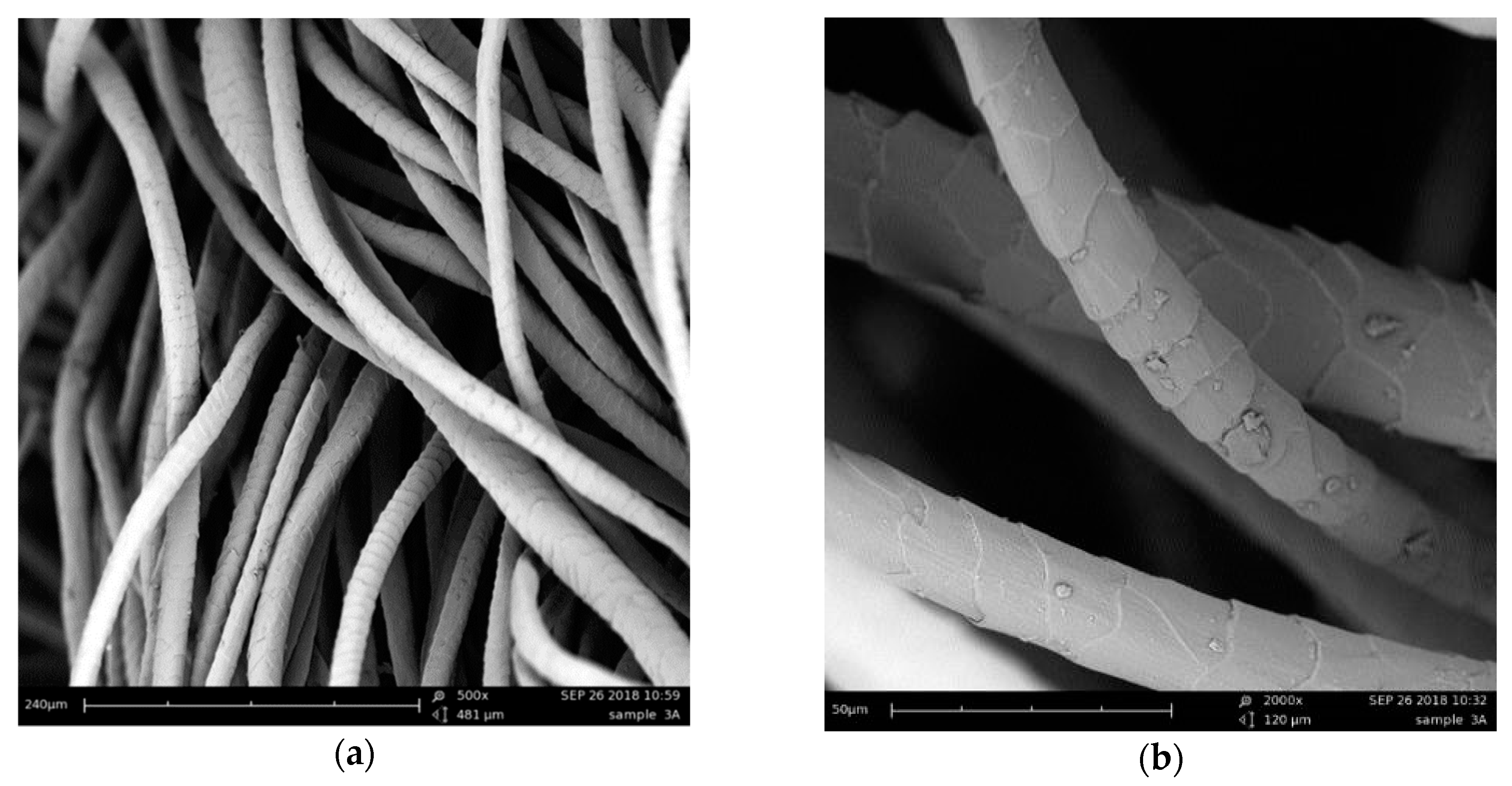
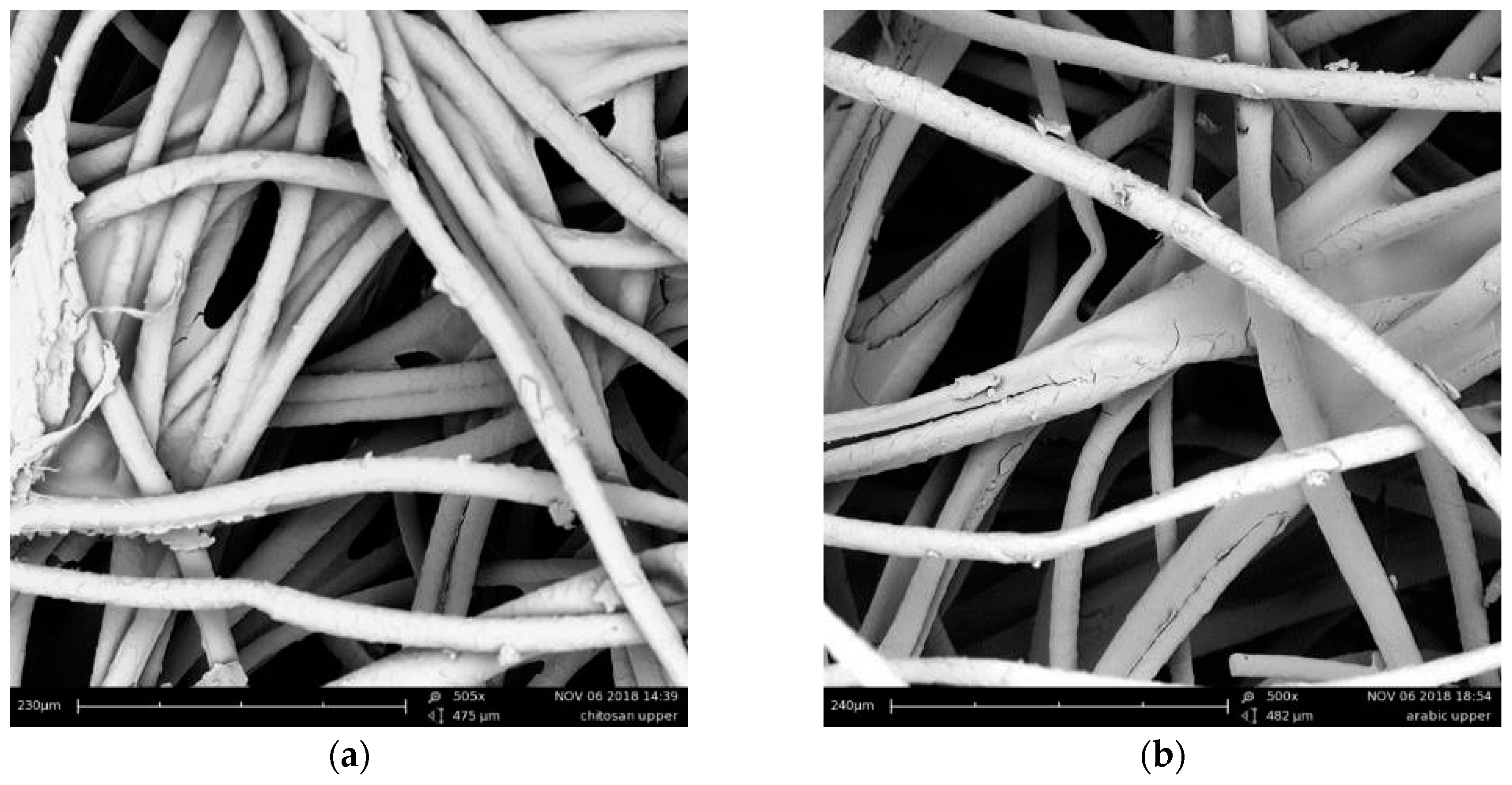
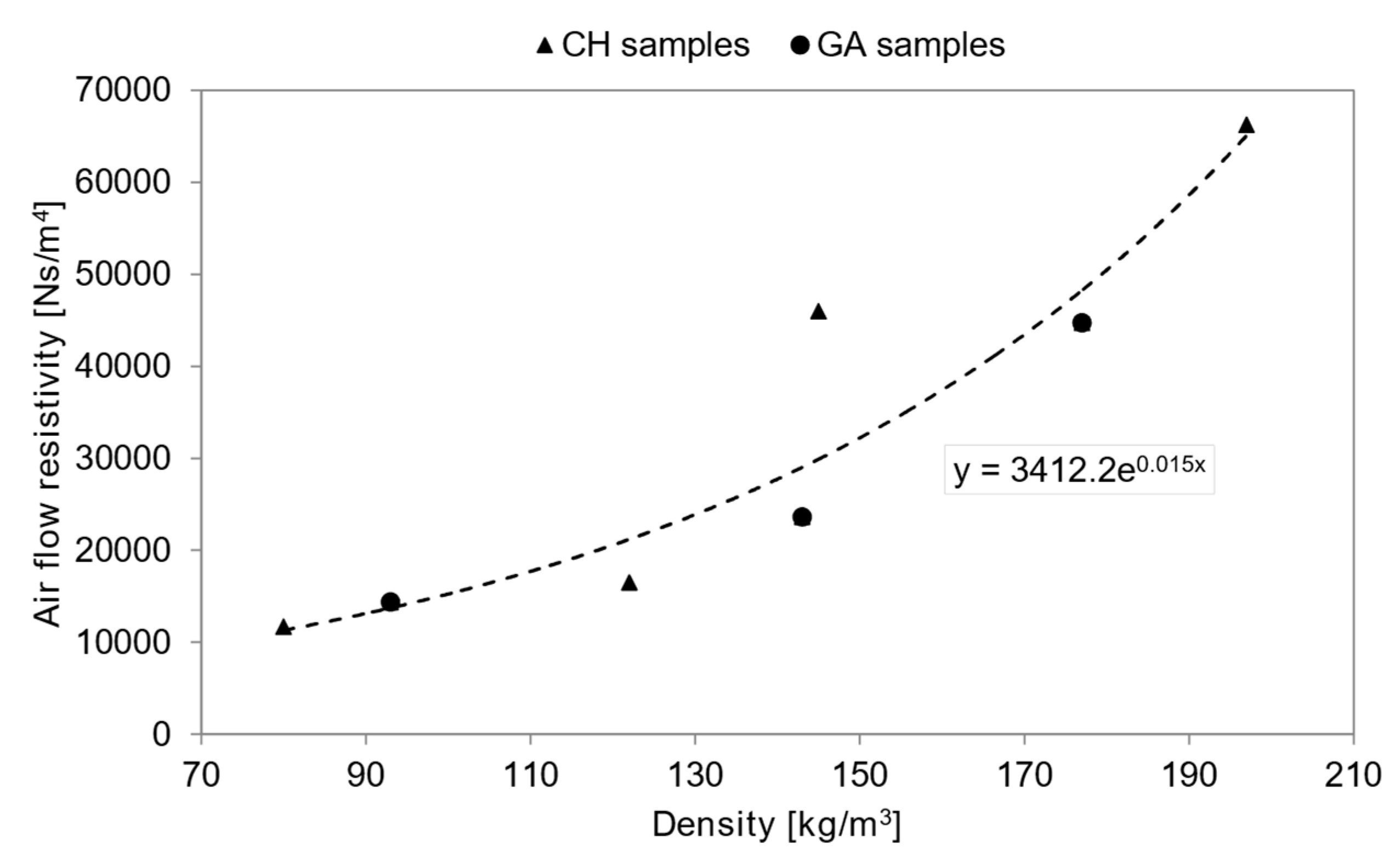
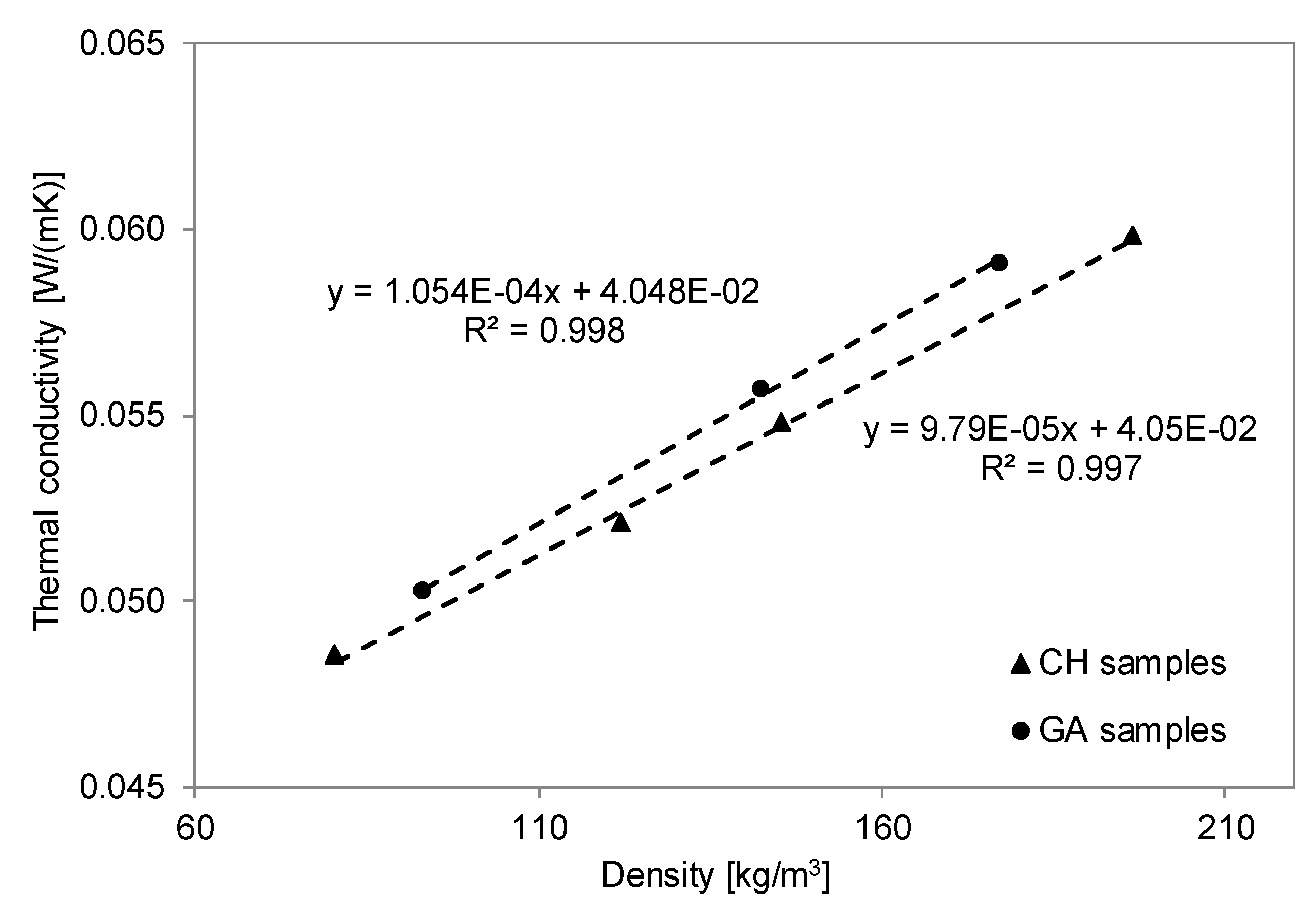
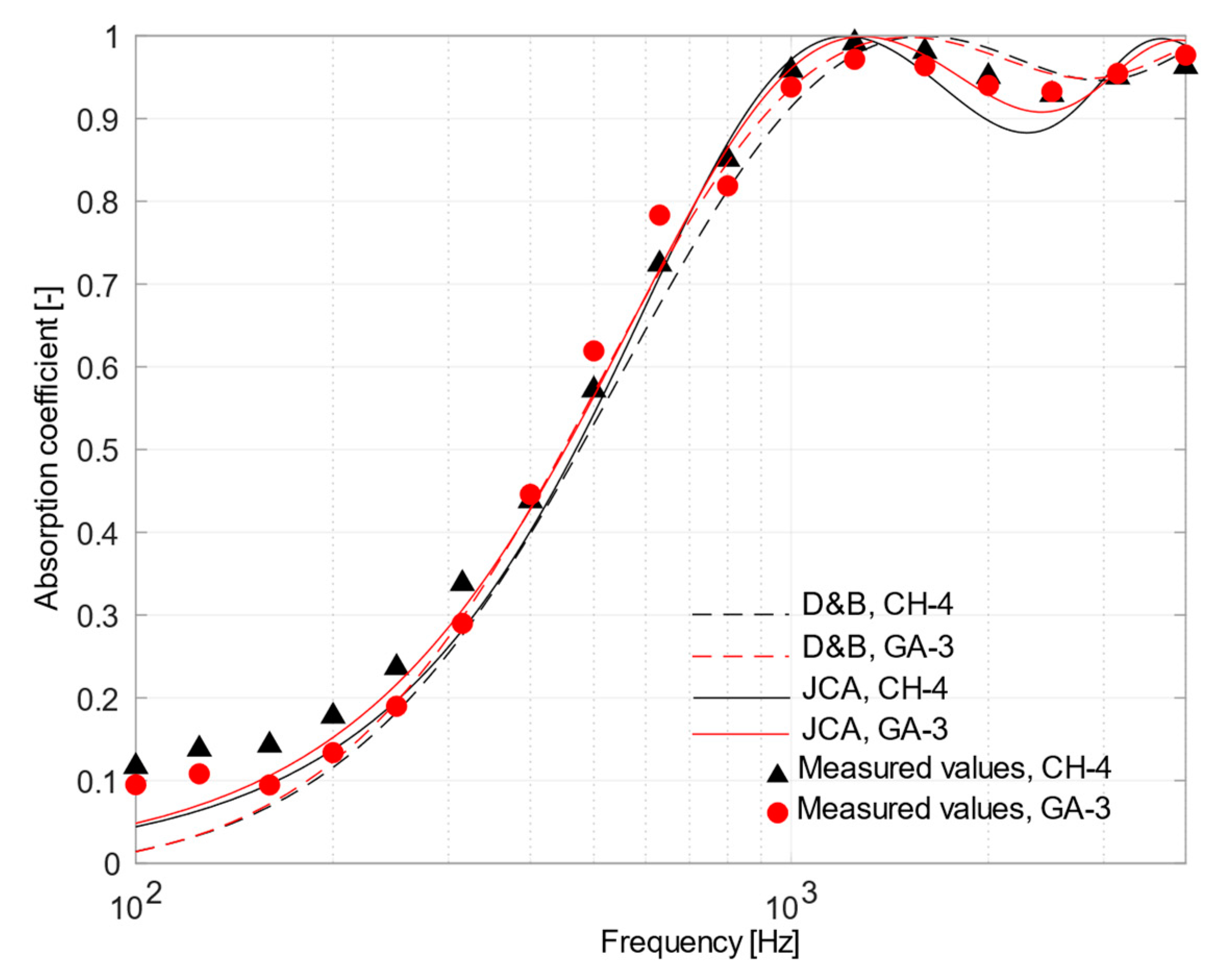
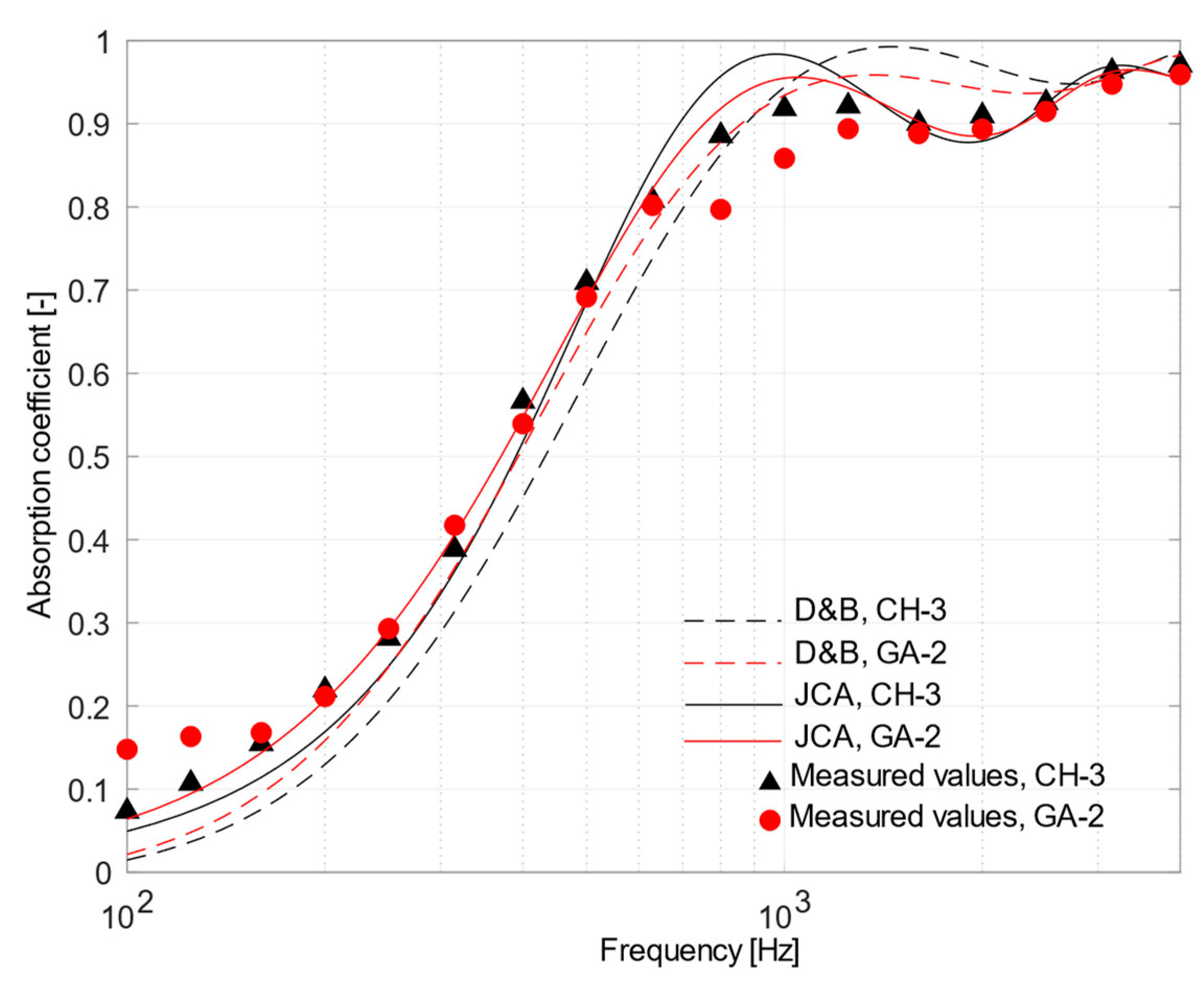
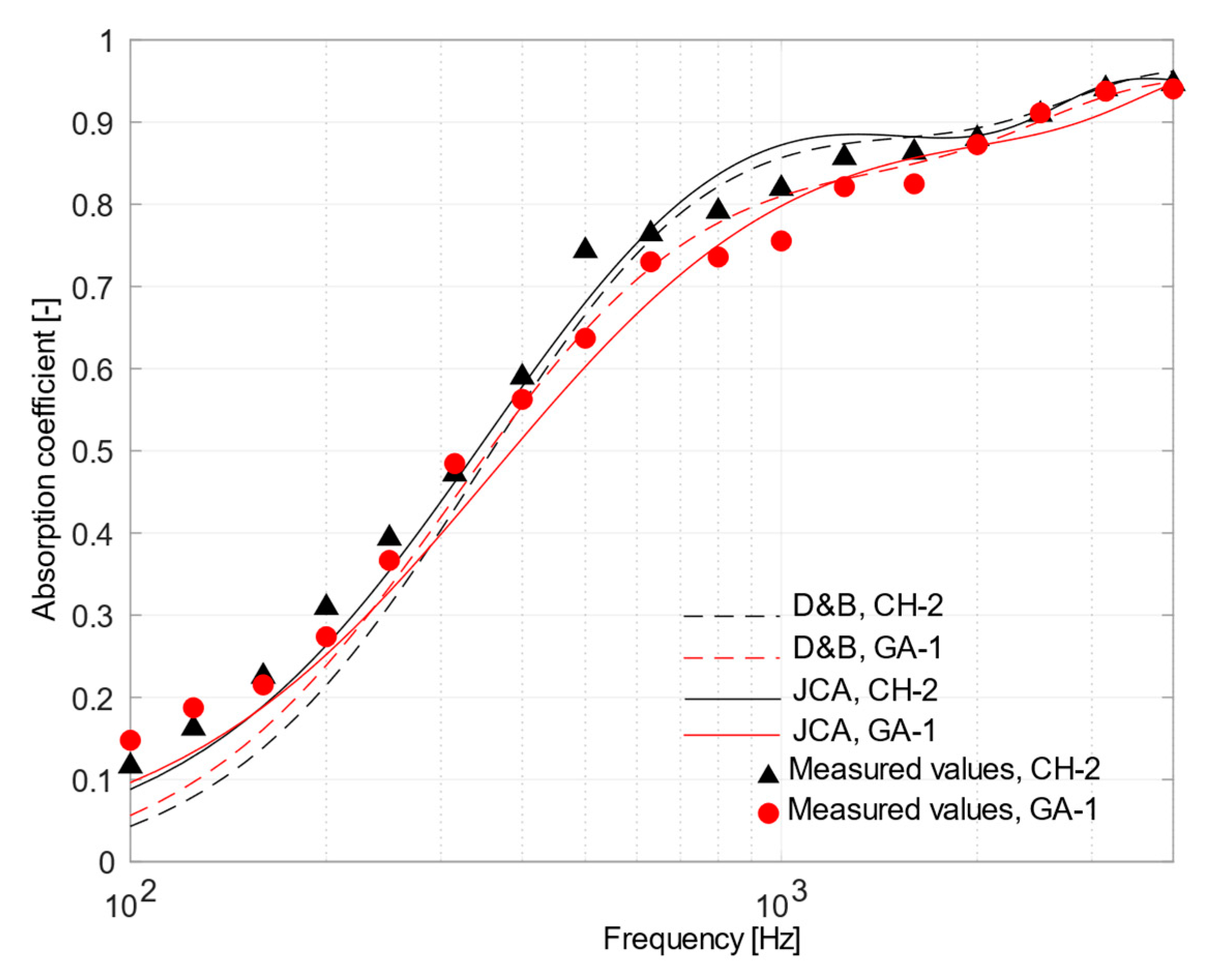
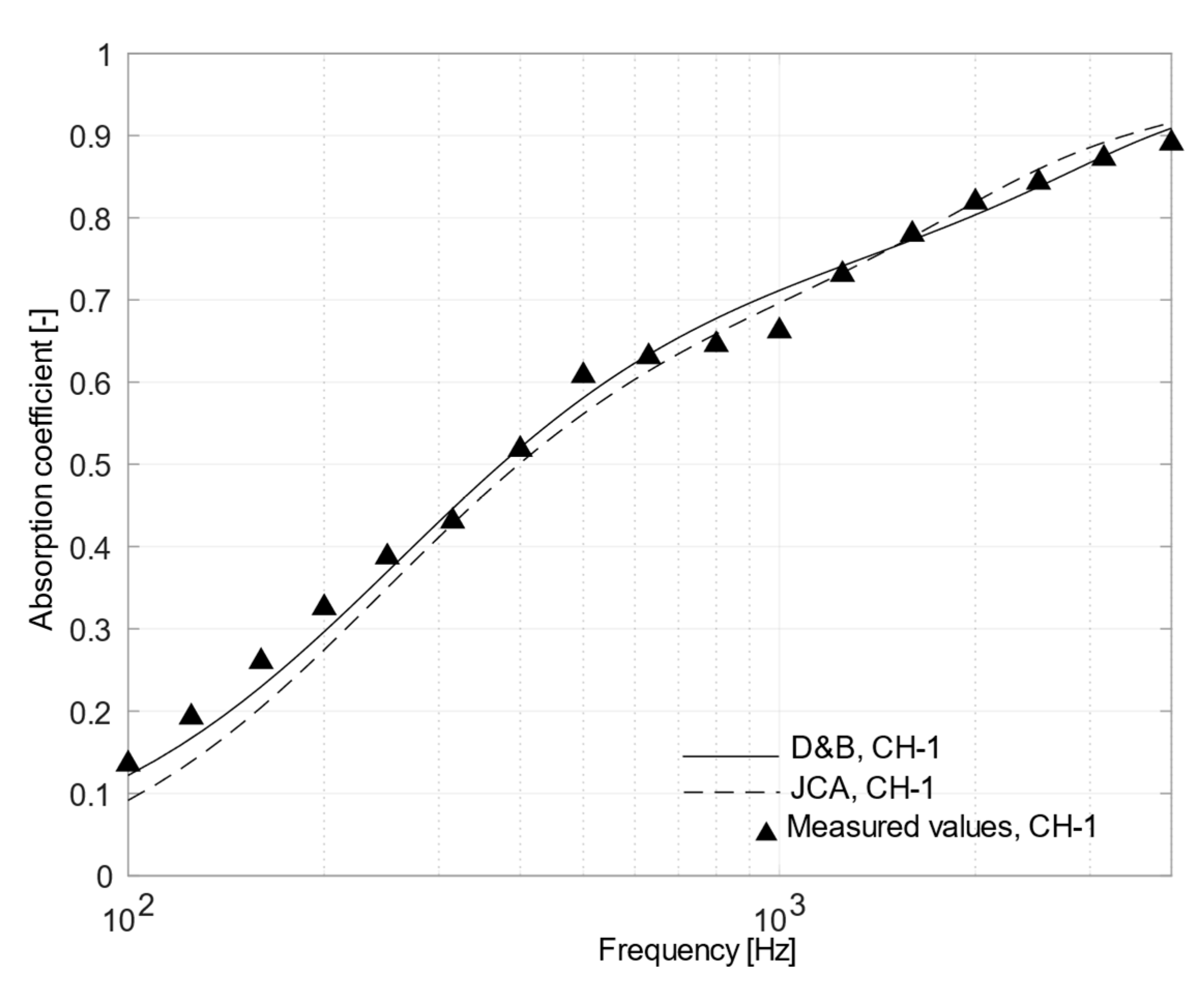
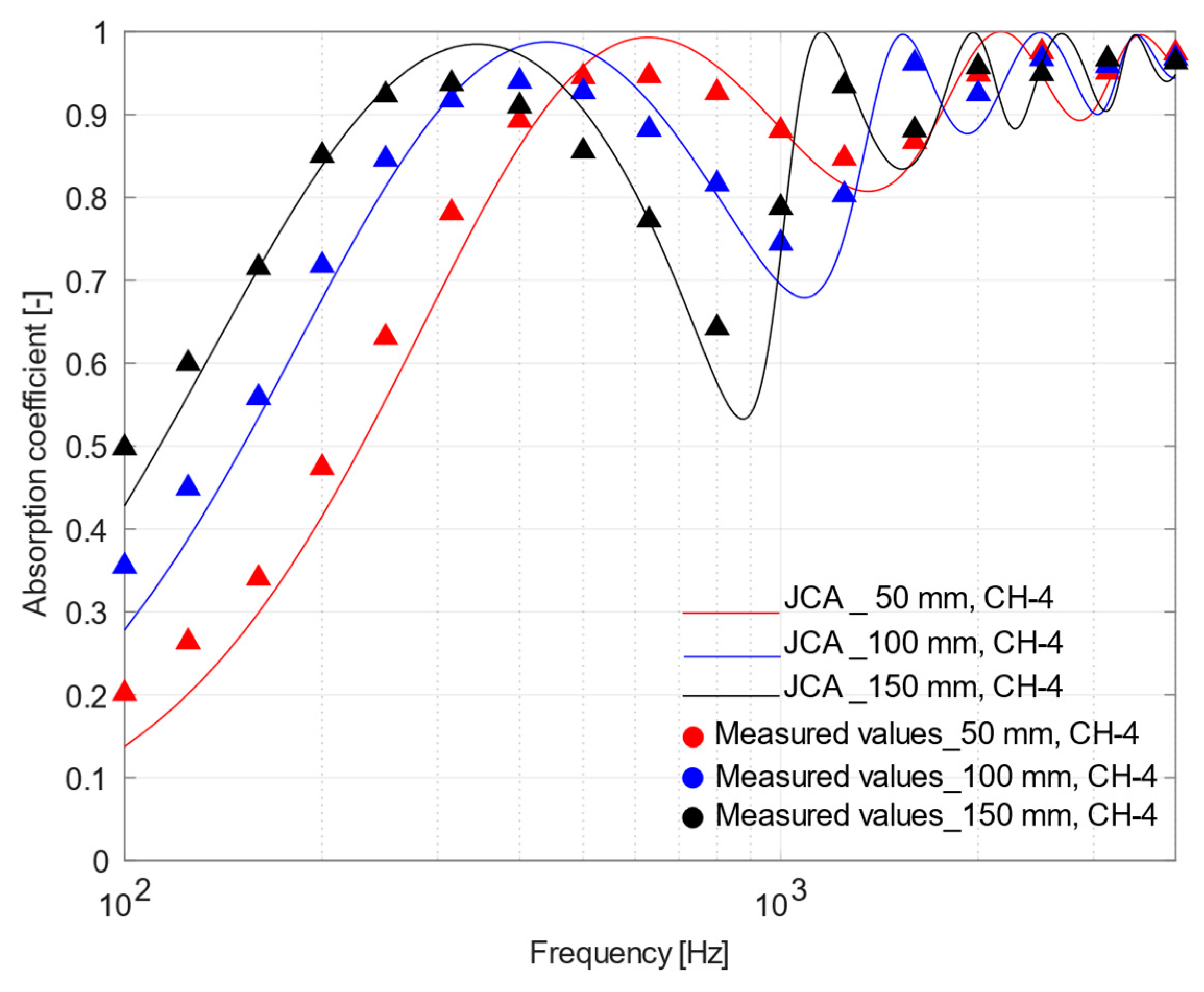
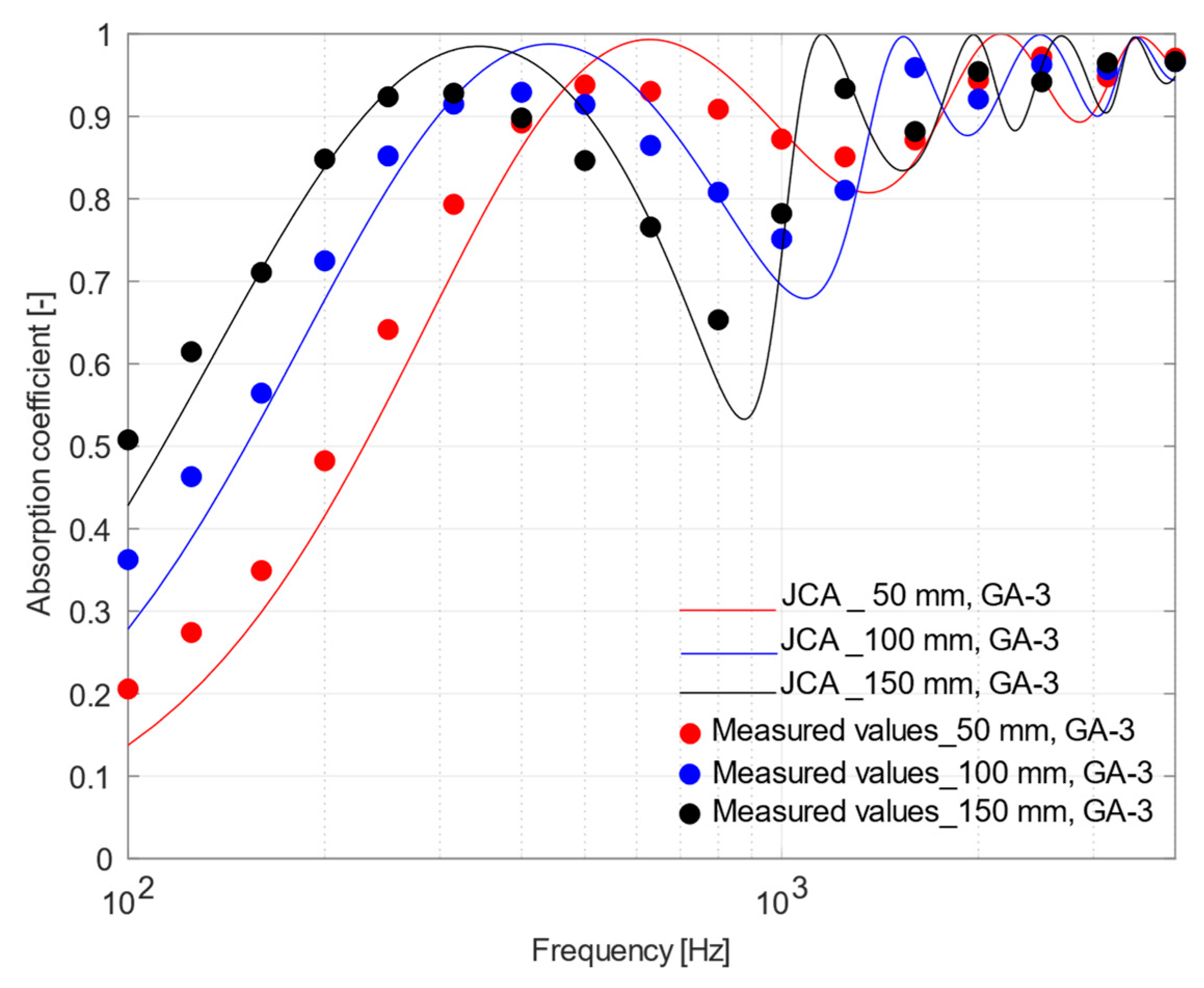
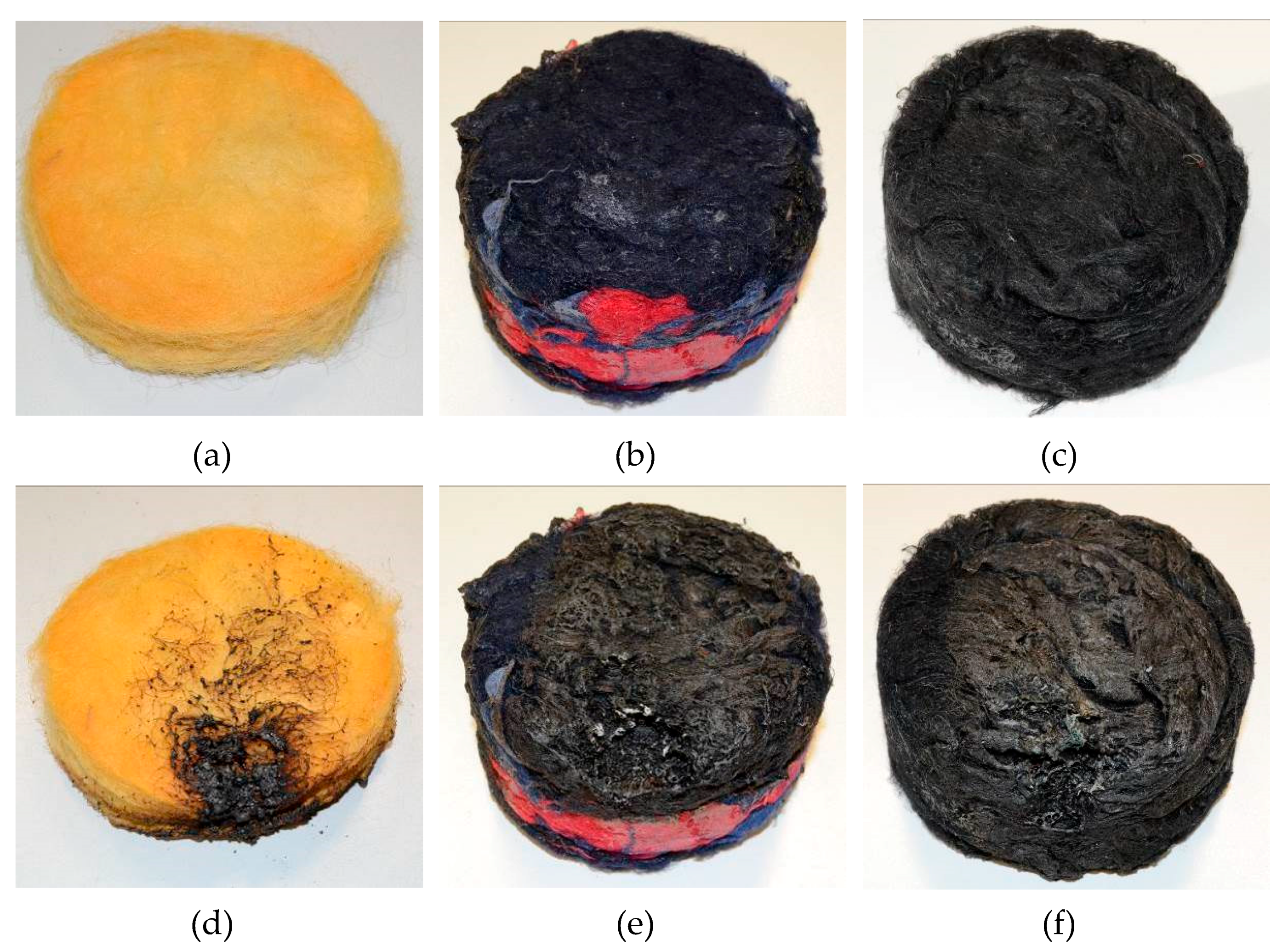
| Solution | Solute [g] | Water [g] | Acetic Acid [g] |
|---|---|---|---|
| Chitosan | 15 | 1000 | 5 |
| Gum Arabic | 200 | 1000 | - |
| Sample ID | Bulk Density ρ | Fibrous Matrix | Binder | Fibrous Matrix | Binder |
|---|---|---|---|---|---|
| [kg/m3] | [wet %] | [wet %] | [dry %] | [dry %] | |
| CH-1 | 197(1.7) | 40 | 60 | 95 | 5 |
| CH-2 | 145(1.6) | 40 | 60 | 95 | 5 |
| CH-3 | 122(1.2) | 40 | 60 | 95 | 5 |
| CH-4 | 80(1.0) | 40 | 60 | 95 | 5 |
| GA-1 | 177(2.9) | 40 | 60 | 78 | 22 |
| GA-2 | 143(1.6) | 40 | 60 | 78 | 22 |
| GA-3 | 93(1.1) | 40 | 60 | 78 | 22 |
| Sample Code | Bulk Density, ρ | Porosity, N | Measured Tortuosity, τ | Estimated Tortuosity, τest | Air Flow Resistivity, σ | Thermal Conductivity, λ |
|---|---|---|---|---|---|---|
| [kg/m3] | [-] | [-] | [-] | [kN·s/m4] | [W/(m·K)] | |
| CH-1 | 197(1.7) | 0.86(0.002) | 1.23(0.07) | 1.08(0.0028) | 66.3(7.8) | 0.060(0.0005) |
| CH-2 | 145(1.6) | 0.89(0.001) | 1.11(0.05) | 1.06(0.0008) | 46.0(9.1) | 0.055(0.0007) |
| CH-3 | 122(1.2) | 0.91(0.001) | 1.12(0.05) | 1.05(0.0013) | 16.5(2.7) | 0.052(0.0006) |
| CH-4 | 80(1.0) | 0.94(0.001) | 1.20(0.18) | 1.03(0.0016) | 11.7(2.2) | 0.049(0.0005) |
| GA-1 | 177(2.9) | 0.87(0.0014) | - | 1.08(0.0019) | 44.7(5.0) | 0.059(0.0012) |
| GA-2 | 143(1.6) | 0.90(0.0003) | - | 1.06(0.0004) | 23.6(2.5) | 0.056(0.0006) |
| GA-3 | 93(1.1) | 0.93(0.0004) | - | 1.04(0.0006) | 14.4(2.3) | 0.050(0.0005) |
| Sample Code | Shape Cactor, s | Ratio, Λ′/Λ | Mean Absolute Error |
|---|---|---|---|
| [-] | [-] | [-] | |
| CH-1 | 2.0 | 2 | 0.0172 |
| CH-2 | 0.8 | 2 | 0.0240 |
| CH-3 | 3.0 | 2 | 0.0295 |
| CH-4 | 2.0 | 2 | 0.0334 |
| GA-1 | 1.5 | 2 | 0.0307 |
| GA-2 | 2.5 | 2 | 0.0304 |
| GA-3 | 2.0 | 2 | 0.0263 |
© 2019 by the authors. Licensee MDPI, Basel, Switzerland. This article is an open access article distributed under the terms and conditions of the Creative Commons Attribution (CC BY) license (http://creativecommons.org/licenses/by/4.0/).
Share and Cite
Rubino, C.; Bonet Aracil, M.; Gisbert-Payá, J.; Liuzzi, S.; Stefanizzi, P.; Zamorano Cantó, M.; Martellotta, F. Composite Eco-Friendly Sound Absorbing Materials Made of Recycled Textile Waste and Biopolymers. Materials 2019, 12, 4020. https://doi.org/10.3390/ma12234020
Rubino C, Bonet Aracil M, Gisbert-Payá J, Liuzzi S, Stefanizzi P, Zamorano Cantó M, Martellotta F. Composite Eco-Friendly Sound Absorbing Materials Made of Recycled Textile Waste and Biopolymers. Materials. 2019; 12(23):4020. https://doi.org/10.3390/ma12234020
Chicago/Turabian StyleRubino, Chiara, Marilés Bonet Aracil, Jaime Gisbert-Payá, Stefania Liuzzi, Pietro Stefanizzi, Manuel Zamorano Cantó, and Francesco Martellotta. 2019. "Composite Eco-Friendly Sound Absorbing Materials Made of Recycled Textile Waste and Biopolymers" Materials 12, no. 23: 4020. https://doi.org/10.3390/ma12234020







